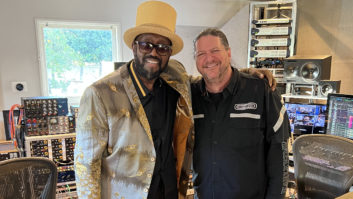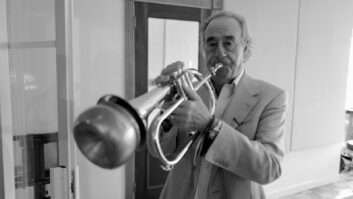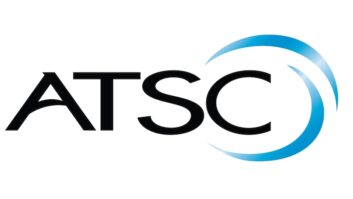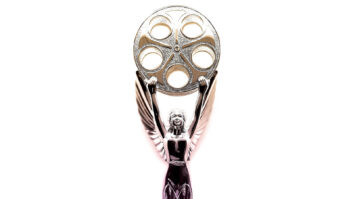When you’re tired of sound-alike mixes and you want your music to sound like your band instead of some over-EQ’d, overcompressed, generic dreck, who ya gonna call? Well, lately a lot of people have been calling Jim Scott. Don’t let his quiet demeanor fool you; in this case, still waters run very deep. Scott is known as much for his unique perspective as he is for his wicked sense of humor. He’s technically demanding (ask any studio tech he’s worked with), fearless, honest and direct. He expects things to be done properly, and if they’re not, he doesn’t tolerate excuses. No doubt, his classic from-the-bottom-up, Record Plant-style education contributed to his M.O., but you get the feeling that Scott has always been uncompromising about quality.
That trait has served him well throughout his career. He had early success and a Best Engineered Album Grammy nomination for his work on Sting’s first solo project, Dream of the Blue Turtles, and a Best Engineered Album win for Tom Petty’s Wildflowers. His prolific body of work includes projects with Santana, the Rolling Stones, Johnny Cash, Robbie Robertson, Matthew Sweet, the Foo Fighters, Matchbox Twenty (More Than You Think You Are), numerous Tom Petty CDs (including the 2002 release, The Last DJ) and the two most-recent Red Hot Chili Peppers releases.
I found Scott ensconced at Hollywood’s Cello Studios, where he was mixing for RCA’s punk/pop group Eve 6. He works at Cello often and has Studio 2 set up just the way he likes it: a custom Neve 8028 console, two integrated Neve BCM10 sidecars and plenty of vibe.
You’re known as an engineer who thrives on working with bands. Did you start out doing live sound?
During college, I had a P.A. and worked with a band. My job was mixer, manager, roadie and producer. We did a lot of gigs and had a lot of fun.
How did you happen to own a P.A.?
My roommate was in a sort of folk-rock band. They were actually really good, with original music and great harmonies, all stacked and syncopated and interesting — sort of like CSN meets Yes. They’d rehearse in the apartment, and I’d be hanging out and listening. But when we’d go to the coffeehouse where they were playing, it never sounded right. You couldn’t hear who was singing lead; sometimes, there was only one mic — all sorts of things were wrong. I knew how it was supposed to sound, and it just wasn’t happening. So I went out, bought a P.A. and said, “Okay, next gig we’re going to get it to sound right.” And that spawned me working with them and getting more involved on a musical level. The P.A.s got bigger, the group got bigger, and the gigs got bigger.
Back up a minute. When you bought that P.A., did you know anything about it?
Just what every other kid who was ever in a band knew — that you needed one. In high school, I played in bands; I was a drummer. Actually, I was the best drummer in Kirkwood, Missouri. Of course, when I came out to L.A., I tried to get in some bands and realized that I was really terrible. I wasn’t used to that.
But you didn’t come to L.A. to study music.
No. I got my B.S. in geology at USC. Graduation and the band breaking up all happened at the same time. Adulthood was suddenly upon me, and I ended up getting a job as a geologist, which was enjoyable, lucrative and professional. My parents were ecstatic.
My son, the geologist!
It was perfect. The only problem was that it felt like an older person’s job, and I didn’t then — and still don’t now — feel very grown up. And for a lot of other reasons — some of them having to do with the fact that the work I was doing involved massive developments on land that had been pristine and beautiful — I ultimately decided it was not the right thing for me to do. So, I ended up getting back into music where I’d always been happy.
How’d you make the change?
The girlfriend of my roommate was a bookkeeper at Record Plant. She told me there were guys who came in as runners and janitors and worked their way up — sort of like going to school. It took me awhile to face the reality of leaving my professional, money-making job and going back to minimum wage; but, ultimately, I did it. And the day they gave me my Record Plant T-shirt and the keys to the studio station wagon, I felt like Rocky Balboa: I’d done it. I was now the master of my own destiny.
You just walked in and got a job?
[Laughs] Not exactly. My friend set up an interview for me. Now, I had a college degree, a professional resumé and I was going in to get a minimum-wage gofer job. [Record Plant owner] Chris Stone looked at the resumé, and it only took him a couple of minutes to say, “I’m sorry, I can’t hire you. You’ve got the wrong education, no electrical engineering degree and you’re too old. You’re going to work for six months, get dissatisfied and quit. That costs me money. I need a guy who’s going to stick with it.”
How did you feel?
I couldn’t believe I didn’t get hired. I went to the bar next door, where they actually had a direct phone extension to the studios. So you could call, say, Rod Stewart and tell him it was time to come back to his session. I went over there and had a beer, and I was telling myself, “This is crazy. What is he thinking?” I picked up the phone and called him. I said, “Thank you for the meeting. I thought about everything you said, and I’m still available to start Monday.” And Chris said, “Okay. Come on in.” I think he was just waiting to see what I’d do. I mean, there was no shortage of resumés; I had to convince him.
How’d it go once you started?
There were a lot of guys who worked there who didn’t make it. They were offended that they had to clean toilets and sweep the hallways, wash the fish tank, clean the Jacuzzi and make up the beds in the bedrooms. To me, it was easy. My parents had raised me and my brothers right: We washed dishes and swept floors; I knew how to work. So it was easy to be better than a lot of the other guys who didn’t want to do those things. I just made sure I was walking down the hall with a rag and a bottle of Windex whenever…
Chris Stone walked by.
Chris, or Lee DeCarlo, the chief engineer, or [manager] Rose [Mann]. And one thing led to another. How hard is it to be a runner? Well, more challenging for some than others, but I was a great runner. And then I was a great night phone-answering guy.
Your route up was the traditional one.
You run for six months, then you janitor for six months. Then you become the head janitor and schedule the other janitors. And if toilet paper doesn’t get bought, it’s your fault; if the coffee and the cocoa don’t get ordered, it’s your fault. After being head janitor for a while, you graduate to the setup department. And if all of the mics that you bring into the room don’t work, it’s your fault; if the cables don’t work, it’s your fault. At Record Plant, the intimidation factor kind of separated the men from the boys. It was really important that your session went well, and it was up to you to make sure that it did. It was a good training system, and you had to be dedicated to endure it.
Didn’t you get involved with live remotes also?
Other than actually getting hired at Record Plant, that was my luckiest break. I missed the setup and the maintenance and the real assistant kind of training, but the training that I got in two years on the road was the best. Every band was starting to need a video, and the quickest way to get one was to record the gig. The Record Plant trucks went on the road and, for a long time, never came home. They needed bodies in the seats, and I had a truck-driving license. Also, I was a little older and able to be trusted with a briefcase full of hundred dollar bills. So, I went on the road, and we did over 500 gigs in two years.
What did you learn from doing remotes?
I learned how to align the tape recorders, how to set up 60 mics and get them all checked and ready to go at 8 p.m., and how to get a balance going out on a broadcast — like that! Over and over and over. Making a rough mix was easy. Doing it all became easy. It was just the job, and it was great fun.
Why did you stop?
I met my beautiful wife, Carol, got married immediately and decided to stay home. I was then put into the studio as an assistant, which I did for about a year, until I was exhausted and broke. I’d made more money on the road; in the studio, I was earning five dollars an hour. I was working around the clock, regularly 100 to 125 hours a week. [Laughs] In fact, for Chris Stone’s birthday a couple of years ago, his daughter called and asked if I’d make a page for a book for him. I sent him one of my old pay stubs showing those hours and wrote, “Thanks a lot!”
They wouldn’t pay you more?
I’d gone in to get a raise after I’d worked myself up to being the top assistant. You didn’t move up until someone above you either got fired or quit, but finally, I was the top guy and I knew it. I knew everything, and I’d been working on all of the big gigs. I went in to get a 25-cent-an-hour raise. And Chris said, “You’re at the top of the pay scale. I’m sorry, but that’s the way it is.” So I said, “Well, here’s my notice. I need to find a better job.” And he said, “Great! That’s good! Now you’re a recording engineer. Go out and bring me a client.”
Then you were on your own. What did you do?
I did demos and “super-assisting” for Record Plant. They would call me back when they had a problem. And I got another big lucky break. They called me in and said, “We’ve got a guy here from England who’s on the scoring stage trying to do a cinema release of a Police Synchronicity video. He’s locking up three mag machines and two multitracks over there with the union guys and it’s not working. Will you go over and straighten everything out?”
I went over and met [producer] Pete Smith. I got everything bused and straightened out, and I told him to just do his thing and that I would make sure everything was going good technically. After that job, six months went by, then Pete called and said, “I’ve just been asked to produce Sting’s solo album. Would you like to come to Barbados and engineer?”
Suddenly, I was a recording engineer, flying to Barbados, making a big record with a guy that I had done a good job for, which just goes to show, if there’s anything to teach assistants, it’s that you’ve got to be great. I mean, you never hear anybody say, “Hmmm, I’m double-booked and I need somebody to do these vocal over-dubs. Get me somebody who’s not very good to do it.” No one ever says that. You’ve got to be on your toes — every day, every job.
That record was Dream of the Blue Turtles and you were nominated for a Grammy.
Yeah, and after that I thought, of course, every record I did was going to get a Grammy nomination. Instead, I didn’t work for a year. I was totally under the radar. I didn’t have a manager; people didn’t know how to get in touch with me. Eventually, though, one thing led to another. You keep meeting people, doing a good job, you don’t get fired too many times, and the next thing you know, you’re getting interviewed for Mix magazine.
You’re mixing today, but you don’t have many cables in the patchbay.
Sometimes there are more patch cords than at other times. But I’m not into that school where every channel has to have a Pultec or an 1176 on it. In general, I use a few pieces that are very powerful. And the record that I’m working on right now [for Eve 6] came to me in good condition. It already sounds really good.
What are some of those powerful pieces of equipment?
It’s the most obvious stuff, really. I have an old 1176 from a Record Plant remote truck that I like to use on lead vocals. It’s the best one I’ve ever heard. I use a slap machine for delay, a ¼-inch going really slow, 3¾ ips. I have a Gates [Sta-Level] compressor and a Fairchild stereo compressor that I use like reverbs: I return them to the console and send different things to them.
The Gates is a very powerful compressor, in that it’s only going to get so loud. [Laughs] But then you can just keep cramming things into it until they excite the speakers the way you want the record to sound. It’s mono. I put it right up the middle, and I put everything in it that needs to be bigger, deeper, wider, fatter — whatever needs some strong centering and more apparent volume. You can put the kick and the snare and the bass guitar into them a little bit, in different amounts, and really lock them together, really bring them forward into the mix without making them louder.
Something else about the Gates: A mono Fairchild has 12 tubes in it, and it costs $15,000. A Sta-Level has the same front six tubes as the Fairchild, but it only costs $1,000. They’re slow, of course; they take forever to release. Slow release is in 24 seconds; fast is 12. It’s not as all-purpose as the Fairchild, but it has such a strong sound, and for the money, it’s a great compressor. You really need a Neve board to pull it off, though. There’s an incredible amount of level coming through that thing, and other consoles just don’t hold it.
You can also do things like that in stereo with the Fairchild. If there’s something wrong with the way the guitar on the left is, you can stick it in the compressor a bit and it might get a little fatter, a little louder and just sort of become “more,” rather than just turning it up or EQ’ing it a lot. Really, it’s all about balance; everything else is way less important. Especially with everything being digital now, you have to figure out a way to make things both really loud and really dynamic at the same time.
What’s some other favorite gear?
The things I’ve collected the most are compressors. I have a couple of United Audio 175 tube compressors. They were the precursor to the 1176, the tube version. They do both the tube thing and the 1176 thing. They’re slow, but they’re fat and they distort really beautifully.
I’m also the proud owner of a lot of guitar amps. I have them around for my clients, plus I love looking at them. I’ve gravitated toward the ’60s Fender stuff: Princetons, Bassmen, Bandmasters, Tremolux, Vibrachamp. I actually think if you get a half-dozen of those amps in the room, the vibe gets better.
The equipment-collecting thing started when I was an assistant. It would be three in the morning, the guitar player would break his last pick and there wasn’t another anywhere. So, being the incredible assistant that I was, I started having my own personal supply of picks and strings and straps and cords and snare drums, and drum sets. Along the way, it turned into everything.
Speaking of electric guitar amps, what mics do you rely on for them?
[Shure SM] 57 and a [Neumann] U87 on the same speaker. I put the 57 kind of right in on the cone, and I put the 87 just slightly off between the cone and the rim. You can’t get them too far apart because of phasing; you have to listen carefully. That gives you a “good mic, bad mic,” “bright mic, dull mic” combination you can play with without having to engage an equalizer.
How do you pick which speaker to mike?
One way I do it is to turn the amp on at the volume the guy’s going to play at and listen to the sound — the hum or buzz — it makes at idle. Then I’ll put on headphones and take a mic around, speaker to speaker, on different parts of the speakers, until I find the sound that’s most like the sound the amp makes without any signal going through it.
You were collecting old gear long before everyone got into it, like the Neve BCM 10 you got back around 1986.
Well, the sound of these [Neve 80 Series] consoles is so good and so fat — it’s the most important part for me. It’s what everybody talks about. It’s loud, bright, sweet, warm, big. They distort in such a beautiful way; it’s the whole sound of rock ‘n’ roll.
But your first big record was done on an SSL.
Yeah, there was an SSL at Eddy Grant’s studio in Barbados, and an SSL at Morin Heights in Quebec where we mixed. So it just goes to show it doesn’t really matter what you’re working on: If you’ve got hit songs and a great singer, no one cares what the console is.
I learned on APIs and on SSLs, and they sounded great. But at one point, Daniel Lanois was producing Robbie Robertson’s first record and I got hired to engineer it. We were at the Village in Studio A, when it had an SSL. We were trying to get drum sounds, and Jeff DeMorris, who was my assistant on that project, said, “We’ve got this sidecar; you might really like the sound of it.” Now, I’d never worked on a Neve, never even seen one. He brought it in, hooked it up, and the tom went boom and the snare drum went boom. I was, “Okay, what is this magic trick?” The next day, I called Dave Hadler. He brought one over, and I bought it for $6,000.
I feel that [the Neve sound] makes my job easier. Because when people say, “Can you give me some more bottom?” and you’re working on an SSL, at some point, it says, “No, I’m done here.” And then you’ve got to actually be talented and figure out some kind of way to get some kind of incredible booming bass when the equipment you’re using is sort of getting full. It’s not really a criticism; everything has different limits. For me, with these Neve boards, the limits are just more expanded.
I see you have a very colorful pair of KRK E8s. Are those your main monitors?
I really love them. I also like the ProAcs. Rick Rubin, at the moment, is a big ProAc fan, so the Chili Peppers record was mixed on them. Everything takes a bit of adjustment. I don’t go switching back and forth all day long. I like the E8s. They get loud, they also sound good quiet, and they take a beating and don’t break. And I like the paint job. I saw Bette Midler had a pair of leopard-painted ones, and when I bought my two sets, I got this set with flames and another set that’s like a purple metallic Mopar kind of color — very sexy.
The last time I was here, you were recording to an ancient 1-inch Scully 8-track recorder for [Chili Peppers’ guitarist] John Frusciante’s record.
We did a lot of different things on that record. John wanted to create a mood so that when the music started, you were already in a certain space. He didn’t want to make a ’60s or an ’80s record; he just wanted such a sound for some of the songs, so we used old tape recorders to create it. I’m not saying that the Scully is great; it’s just unique. If you want a certain kind of sound, you have to use the equipment that created it. So, with [Cello chief engineer] Gary Myerberg — who thinks that kind of thing is fun and interesting — we were able to resurrect those old tape recorders. We used the 8-track on, I think, eight of the songs. The others were recorded on 24-track, except one, where we recorded the basic track to a Scully 2-track and then bounced it to a 24-track for overdubs.
John’s record is a really great combination of sounds: Organic beauty recorded in a sort of old-school style, all mixed together with modern, very creative digital sound. He’s also going to knock people out with his singing. I suspect people have no idea how good he is.
You’ve been doing this awhile. What keeps you going?
I have a great time at work every day. After all, it’s something I did for free for the longest time. The band I worked with in college? We’re still friends. Back then, I recorded demos for them in every possible situation: in garages, houses, through the P.A., at gigs. I had a huge collection of tapes in all kinds of formats. This year for Christmas, it was all compiled into Pro Tools. We transferred and mixed, and put everything I’d ever recorded for these guys together into this 13-hour, 11-disc anthology. All of that music, for all of those years, I did for free because I loved it. Now I get paid to do it, and I get to work with some of the biggest bands in the world. I still love it.
Maureen Droney is Mix’s Los Angeles editor.
SELECTED CREDITS
E=engineer, M=mixer, P=producer
Barenaked Ladies:Disc One: All Their Greatest Hits (2001, P/E/M), Maroon (2000, E)
Johnny Cash:American Recordings (1994, E/M)
Counting Crows:This Desert Life (1999, M)
Foo Fighters:One by One (2002, M)
John Frusciante: forthcoming release
Matchbox 20:More Than You Think You Are… (2002, M)
Tom Petty and The Heartbreakers:The Last DJ (2002, E), Playback (1995, E/M)
Lisa Marie Presley:To Whom it May Concern (2003)
Red Hot Chili Peppers:By the Way (2002, E), Californication (1999, E/M)
Whiskeytown:Stranger’s Almanac (1997, P/E/M)
Wilco:Summer Teeth (1999, M), Being There (1996, M)
Lucinda Williams:Car Wheels on a Gravel Road (1998, M)







